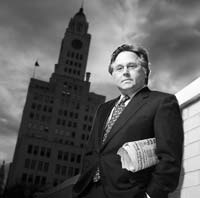Press Lord 2.0
Can a self-made ad man with big ideas and a Walter Annenberg fascination save the Inquirer and Daily News? Maybe. But when Brian Tierney’s finished, the newspaper business may never be the same
THEY HAD LET THE PLACE GO TO HELL. Tierney could see it the first day he walked in the door. In the lobby alone, the paint was peeling and the floor was dirty. The reception desk was plated with metal that gave off a chilly, clinical vibe. Off in the corner was an old Panasonic on a TV cart, an orange extension cord trailing out the back. The TV was at least a decade old, and the cart was the kind of rickety thing you’d be embarrassed to see in a high school, the kind you put out at the curb on trash day and hope somebody takes. On the wall, a United Way plaque from 1988 hung askew.
This was about a year ago. Brian Tierney didn’t own the lobby yet, didn’t own the crappy TV cart and the United Way plaque and the 2,650 employees who worked in the white, magisterial, decrepit building at 400 North Broad, longtime headquarters of the Philadelphia Inquirer and Daily News. He was just here to check the place out, along with the other potential owners of the two troubled Philly newspapers. This was a day of due diligence. The sellers would give PowerPoint talks on the newspapers’ revenues (declining), circulation (declining) and labor environment (tricky, involving 11 different unions), and the bidders would ask questions. Then they’d talk to their investors and submit their bids.
And then Tierney would lose. Big. Or so most folks thought. This was before Tierney’s campaign inspired anything but derision and laughter. Before journalists noted that Tierney (come on, Tierney? Really? The ad guy? The GOP spinmeister?) was pursuing the very same papers he’d spent his career mau-mauing on behalf of his clients. Before he raised $150 million in equity. Before Tierney actually won the papers — then threw a party, complete with string band, and promised his journalists he wanted to build the business, not cut it. Before the ad market started tanking. Before he told this magazine in late August, and his own newsroom managers in late October, that he might have to lay off up to 150 people after all. Before he showed up at a Halloween party dressed like Superman, complete with the red underpants and attendant red bulge. Before journalists started programming his cell number in their phones under the name FUCKFACE and gossiping about the caricature somebody had drawn of Tierney’s head in the shape of — was it a penis or a pig?
No, Tierney was still an underdog, a long shot, on due-diligence day. He and the other bidders rode the elevator up to the 12th-floor publisher’s suite and filed into a large conference room. Tierney looked up. It wasn’t just the lobby that had gone to hell, because there on the ceiling was an ancient glass chandelier, filthy with dust. Probably hadn’t been cleaned since the Summer of Love. Oh God, and an actual pull-down projection screen, the kind your driver’s ed teacher used for showing The Last Prom. But that wasn’t even the most egregious detail. During a break between PowerPoints, Tierney walked out to a nice patio there on the 12th floor and saw paint flaking off the side of the building, huge chunks of it peeling, fading, like on some old beat-up home. …
Not that Tierney had expected a slick operation. He’d run the city’s largest advertising and PR agency for years, so he knew how far the papers lagged behind the ad industry’s best practices. He also knew that the Inky was too important to avoid. If you were buying media for a client, you couldn’t buy around the Inky. For Tierney, it was infuriating, because as America was becoming this paradisical place for entrepreneurs, an entrepreneur’s autobahn, there was this tanklike thing blocking the road, with thousands of guys like Tierney riding the clutch behind it, in their black Benzes, yelling stuff that would have made their grade-school nuns turn red — and what’s worse, the Inky acted like it knew it was this immovable tanklike thing, and didn’t care.
But that was just Tierney’s impression, as an outsider. It wasn’t until he finally bought the papers and got inside that he realized the extent of it, just how much the shelves had been stripped bare. No sooner had he banished the TV cart from the lobby, painted the walls, scrubbed the floors, added wood paneling to the reception desk, replaced the driver’s-ed pull-down with a 54-inch flat-screen plasma, than he discovered there was no employee manual. No performance reviews. Some of the trucks were 20 years old. The computer technology at the printing plant was 14 years old. The Inky’s culture was adaptive to a different kind of media world, the Old World of buildings and institutions.
Journalists, especially. The way they thought was so alien to Tierney. Most of them seemed happy to be semi-anonymous cogs in a big, important machine. To Tierney, this was as counterproductively Old World as the crappy TV cart in the lobby. Journalists weren’t journalists anymore. They were brands. That’s what the New World of media was all about: bytes and brands. Tierney didn’t create the New World. He just lived there. And now that he, Brian Tierney, not some distant dysfunctional corporate overlord, had control and responsibility for these papers, he’d make sure his journalists learned to live in the New World, too. [MORE]
[Photo by Bill Cramer]
Curated News, Culture And Commentary. Plus, the Usual Sex, Drugs and Rock n' Roll

